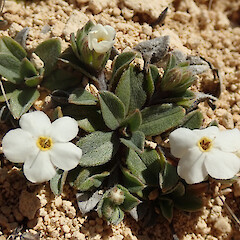Myosotis colensoi
Common name
Castle Hill forget-me not
Synonyms
Exarrhena colensoi Kirk, M. decora Kirk
Family
Boraginaceae
Flora category
Vascular – Native
Endemic taxon
Yes
Endemic genus
No
Endemic family
No
Structural class
Herbs - Dicotyledons other than Composites
NVS code
The National Vegetation Survey (NVS) Databank is a physical archive and electronic databank containing records of over 94,000 vegetation survey plots - including data from over 19,000 permanent plots. NVS maintains a standard set of species code abbreviations that correspond to standard scientific plant names from the Ngä Tipu o Aotearoa - New Zealand Plants database.
MYOCOL
Chromosome number
2n = 46
Current conservation status
The conservation status of all known New Zealand vascular plant taxa at the rank of species and below were reassessed in 2017 using the New Zealand Threat Classification System (NZTCS) – more information about this can be found on the NZTCS website. This report includes a statistical summary and brief notes on changes since 2012 and replaces all previous NZTCS lists for vascular plants.
Please note, threat classifications are often suggested by authors when publications fall between NZTCS assessment periods – an interim threat classification status has not been assessed by the NZTCS panel.
- Conservation status of New Zealand indigenous vascular plants, 2017 . 2018. Peter J. de Lange, Jeremy R. Rolfe, John W. Barkla, Shannel P. Courtney, Paul D. Champion, Leon R. Perrie, Sarah M. Beadel, Kerry A. Ford, Ilse Breitwieser, Ines Schönberger, Rowan Hindmarsh-Walls, Peter B. Heenan and Kate Ladley. Department of Conservation. Source: NZTCS and licensed by DOC for reuse under the Creative Commons Attribution 4.0 International licence.
2017 | Threatened – Nationally Critical | Qualifiers: RR, Sp
Previous conservation statuses
2012 | Threatened – Nationally Critical | Qualifiers: RR
2009 | Threatened – Nationally Critical | Qualifiers: RR
2004 | Threatened – Nationally Endangered
Distribution
Endemic. New Zealand: South Island (easterly from South Marlborough to Canterbury).
Habitat
Limestone talus and thin soils over limestone rock. Most common in open areas of relatively fine limestone debris.
Detailed description
Perennial herb forming small cushions or loose mats on open limestone rock, regolith and associated rendzina soils. Leaves in dense, many-leaved rosettes. Petiole short and broad. Rosette-leaves 20–40 × 5–10 mm, grey-green to silvery-grey above, pale green beneath, lanceolate, apex subacute, base cuneate to attenuate; upper surface covered with tightly appressed, more or less overlapping, intermingled short and long straight hairs, lower surface, sparsely hairy to glabrescent or glabrous; hairs when present, appressed, more or less of equal length. Lateral branches decumbent, 40–80 mm long, leafy, internodes < leaves. Stem leaves and bracts oblong, 10 × 2–3–(5) mm, upper most sessile; hairs as for rosette leaves. Inflorescence cymose, with cymes usually simple, few- to many-flowered. Internodes 2–3 mm. Pedicels 2–3 mm. Calyx 5 mm when flowering elongating to 7 mm in fruit; lobes 2–3 mm, broad, subacute, surface covered with appressed, short and long straight hairs of almost equal proportions, intermingled. Flowers white. Corolla 8–12 mm diameter, tube 5 mm long, cylindric, corolla-lobes, 3 × 2.5–3 mm, recurved; filaments short, anthers 2 mm long, tips just protruding above scales. Style up to 10 mm long, stigma capitate. Nutlets 1.4–1.7 × 0.8–1.2 mm, ovate to ovate-elliptic, black, surface glossy.
Similar taxa
From the other Myosotis species present in New Zealand, M. colensoi can be recognised by its ecological preference for open limestone rock and associated soils, its densely leafy, cushions or mat-forming habit, grey-green to silvery-grey leaves, and rather large, short-stalked, white flowers. It has a superficial similarity to M. cheesemanii because both species have a low cushion to mat-forming habit, and rather leafy, appressed lateral branches. However in M. colensoi the lateral branches extend well beyond the rosette leaves, while those of M. cheesemanii are very short and so hidden within the rosette-leaves of this densely packed cushion-forming plant. The leaves of M. cheesemanii are 12 × 5 mm, elliptic, greener with the upper surface clad in closely appressed, overlapping hairs of equal length.
Flowering
October–January
Flower colours
White
Fruiting
December–February
Propagation technique
An ideal and attractive rock-garden or pot plant. Easily grown from rooted pieces and fresh seed. Best kept in a small pot or planted in a sunny, free draining soil enriched with lime. Will not tolerate humidity, excessive soil moisture or competition from weeds. This is one of the few New Zealand forget-me-nots that is commonly cultivated. In good conditions it often throws seedlings.
Threats
Threatened throughout its range by weeds such as hawkweeds (Pilosella spp.), and grasses such as Festuca rubra, browntop (Agrostis capillaris) and cocksfoot (Dactylis glomerata). Although generally not browsed by animals, plants are often dug out by rabbits, or killed through trampling. Recreational rcok climbers pose a minor threat to some of of the populations at Castle Hill. The greater part of the Castle Hill population is on private land, where it may be vulnerable to changing land use practices and potential quarrying for limestone.
Etymology
myosotis: Mouse-eared
colensoi: Named after William Colenso (7 November 1811 - 10 February 1899) who was a Cornish Christian missionary to New Zealand, and also a printer, botanist, explorer and politician.
Where To Buy
Occasionally available from specialist native plant nurseries and some main, more general garden centres.
Attribution
Fact Sheet prepared for NZPCN by P.J. de Lange (1 February 2008). Description based on Allan (1961)
References and further reading
Allan HH. 1961. Flora of New Zealand, Volume I. Indigenous Tracheophyta: Psilopsida, Lycopsida, Filicopsida, Gymnospermae, Dicotyledones. Government Printer, Wellington, NZ. 1085 p.
NZPCN Fact Sheet citation
Please cite as: de Lange, P.J. (Year at time of access): Myosotis colensoi Fact Sheet (content continuously updated). New Zealand Plant Conservation Network. https://www.nzpcn.org.nz/flora/species/myosotis-colensoi/ (Date website was queried)















